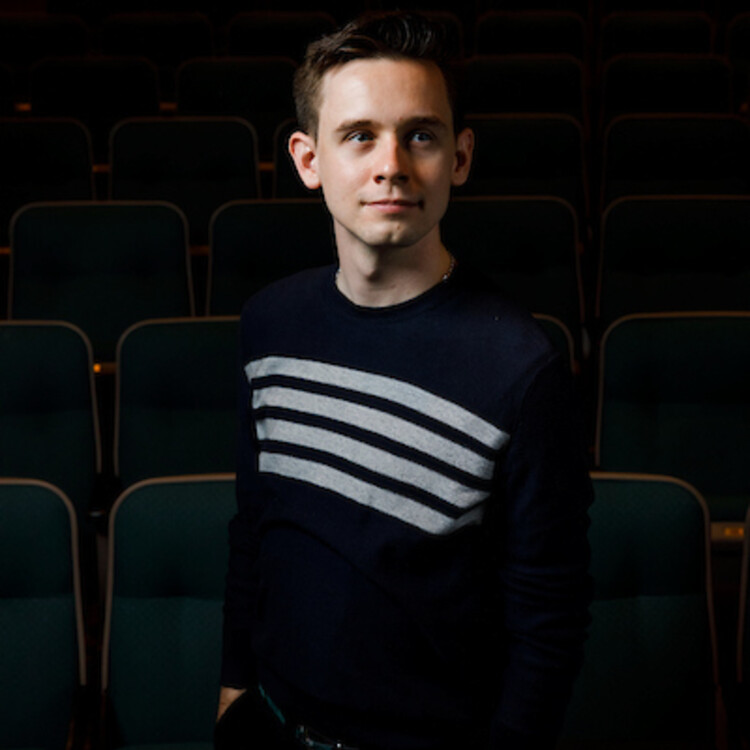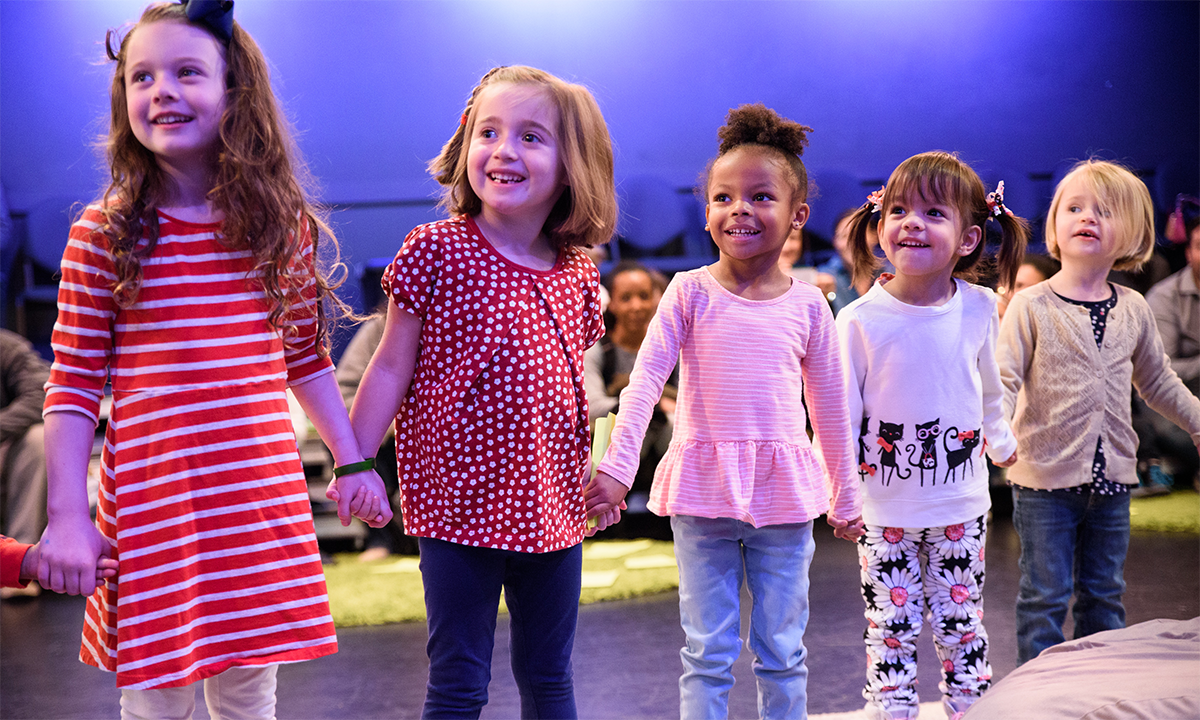Young Folks React Honestly
A director once told me to bring every play to an elementary school for a preview performance because children reveal precisely when a scene loses suspense or clarity, which is true. I worked as an elementary school teacher for four years and I learned two distinct truths about young minds: they absorb the tiniest of nuances and they share honest opinions. Reactions dance on their elastic faces. For example, when I taught five-year-olds, they consistently noticed if I hadn’t shaved that morning. A kindergartener once told me I looked hungover when unshaven. Very young folks not only notice the tiniest detail, but they interpret and share their thoughts uninhibitedly with little tact and abundant innocence. For theatre work, this sort of attention and honesty is invaluable because it offers raw and fresh alertness to the way we communicate in real time, an exchange distinctly beautiful to live performance.
Meet Who’s in the Room with You
Before two shows at the Toddler Takeover—the PaperBoats production of Especially on Birthdays (Australia) and Peut-Être’s Shh...Bang! (United Kingdom)—the actors interacted with the families in the audience. Both productions fed off audience engagement and participation, which inherently requires putting people on the spot, springing the narrative gaze upon them. For some folks, this attention can be empowering. For others, it can be overwhelming. By interacting with the audience, the artists got a sense of who was in the room and to what degree they’d be willing to participate in the storytelling—a practice that welcomes respectful collaboration.
Ditch Preconceived Notions About How Audiences Should Interact with Our Work
As an artistic community, we’re dissonantly formal and conservative in what we deem acceptable audience behavior. Often, the exaggerated sense of ceremony we place on our work silos us. But, like any good forum, the theatre is a democratic soundscape. In Shh...Bang!, the pre-show announcement made it clear that no shushing would be allowed. Despite what the title may imply, everyone was encouraged to react with impulsive noise. In the Alliance’s Gimme Please, audiences were encouraged to go onto the stage to touch, engage, and assist. In one vibrant moment, wooden marbles were poured from a bowl onto the floor and it was up to us, the audience, to use coned birthday hats to collect as many as we could. The loud crash of hundreds of wooden marbles hitting the floor was the sound of glorious, chaotic freedom.
Very young folks not only notice the tiniest detail, but they interpret and share their thoughts uninhibitedly with little tact and abundant innocence.
Design Elements Need Texture and Feel
Whether it was a cold metal ladle that could be used as a drumstick on a plastic bowl in Peppercorn’s bilingual Música, Música, Máximo Música (North Carolina), threads of yarn in Brush Theatre’s Yao Yao (South Korea), fluffy slippers in Shh...Bang!, or crinkled rolls of receipt paper by the yard in Especially on Birthdays and Gimme Please, design elements were tangible and had sensory texture. Theatrical design should not be static or two-dimensional; it should have shape, substance, liveliness, and it should elicit feeling. This is one of the more essential lessons from the Takeover: while quality film and television can represent, entertain, transport, and teach us to think empathetically, theatre can teach us to feel.
Commune with the Audience
At every production in the Takeover, the audience had an opportunity to influence a plot’s trajectory, which aligns with Augusto Boal’s concept of the “spect-actor” where the audience is not simply a passive observer but instead an instigator of dramatic action on the same plane as the actor. Boal insisted this liberty allows audience members to rehearse their own social action outside of the theatre. In the Alliance’s bilingual La Tortuga and The Hare, the audience manipulated the pace of the plot by letting the spect-actors play music, dance, exercise, build a pillow fort, and even eat! When the audience ate carrot slices with the Hare, communion ensued, and the theatre became a sensory place of nourishment.
Clarity Is Connective
The wild, whimsical, abstract, and extraordinary experience of childhood is a global unifier. Despite political inclinations, social barriers, and geographic location, there are universal qualities to the childhood experience for us as a global community. Even though Yao Yao was performed in Korean, the themes of a child’s loneliness and isolation, and how the imagination has a resilient way of filling the crater those feelings create, were crystal clear.
Make the Rhythm Visible and Inescapable.
When thinking of dramatic flow, “rhythm” is a better word than “pace.” This is because it’s more authentic to the experience of consuming theatre, which is primarily a linguistic or auditory medium (after all, even silence is sonic). In the Atlanta Symphony Orchestra’s Music of Africa: The Story of Sugar Boy, rhythm is all around—the actors moved to different stations throughout the venue to musicalize chunks of the story. Each station had its own rhythm, which the audience got to contribute to with their own handheld instrument.
Inviting very young people to participate in a narrative experience requires radical hospitality and humbleness.
Keep It Short: Don’t Hold the Audience in Captivity
New works should be radically short. Are there exceptions? Of course, but they should be thematically deliberate like Taylor Mac’s A 24-Decade History of Popular Music or PearlDamour’s performative installation How to Build a Forest. Brevity demands conciseness, deliberateness, and judiciousness. It also frees the modern audience. Attention spans are shorter because audiences have more entertainment options accessible. This reality is not a tragedy; it democratizes time management because it gives audience members a marketplace for how they can spend their time.
The most dangerous impact of theatre in 2019 is that it can hold an audience captive. A venue’s architecture, seating location, and social codes hold audiences hostage—a sensation that is viscerally and painfully felt when someone is watching a production they dislike. Theatre can seem predatory when audiences feel robbed and trapped. Short shows reduce captivity. And in theatre for the very young, the experience is flexible—there is no shame to moving around the venue or leaving. For busy minds, stories that have an impact are the ones told efficiently.
Let the Audience Own a Piece
At the end of every play at the Takeover, the very young audience was allowed to take the stage and dance, explore, and play. Boal would be pleased with these conclusions because they break down the implied power structure separating the actors and the spectators. Audience members at Shh...Bang! were given bags to collect the feathers that had trickled like snowfall from the lighting grid. The audience was empowered to literally keep the play, taking a piece of it home.




Comments
The article is just the start of the conversation—we want to know what you think about this subject, too! HowlRound is a space for knowledge-sharing, and we welcome spirited, thoughtful, and on-topic dialogue. Find our full comments policy here
Thanks, Alex - I loved reading this. I nodded "yes" enthusiastically from beginning to end. Beautiful articulation of how childhood can intersect with art making and story-sharing.